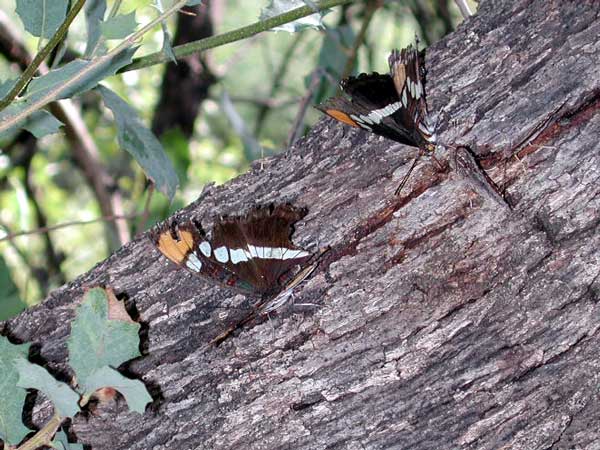Arizona Sister
Adelpha eulalia

Photo from Superstition Mountains, Pinal Co., Arizona, USA. May 2006..
Nymphalidae -- Brush-footed Butterfly Family
More Information:
In deep shady canyons within the Sonoran Desert and more commonly at higher elevations the Arizona Sister is a common and welcome sight. The caterpillars use a variety of oak species as a host plant. In the photo at left there are two adult Arizona Sister butterflies drawing sap from a wound in the trunk of an old oak tree. A closer look will also reveal two additional butterflies, well camouflaged. The two are Asterocampa leilia, Desert Hackberry Butterfly.
Notice that the wings of the sisters are tattered. The tattered wings tell several stories. First the bright, striking colors suggest aposematism - i.e. the butterflies may be distasteful to birds and the colors advertise this. The butterflies' behavior also suggests that they enjoy some protection: they sally conspicuously up and down trails in a sometimes lazy fashion alighting on the ground or near puddles. If chased with a butterfly net, however, they will put on the speed and make rapid maneuvers ... even butterflies with major chunks out of their wings can fly well, reflecting the robust design of the wings that still function when damaged.
The butterflies in the photo are likely less than a month old. During their short adult lives they face many dangers. One chunk out of the rear wing is rounded suggesting a lizard bite, whereas a sharp triangle bite almost certainly was that of a bird's beak. The breakable wings are an effective defense for the butterfly, often leaving a predator with a dry wing chip and some slippery wing scales, and the butterfly with an escape.
Flowers and butterflies seem to be made for each other, but in this case neither of these butterfly species are partial to flowers at all. Instead they sip from sappy tree wounds, rotting fruit, dung or even rotting carcasses!